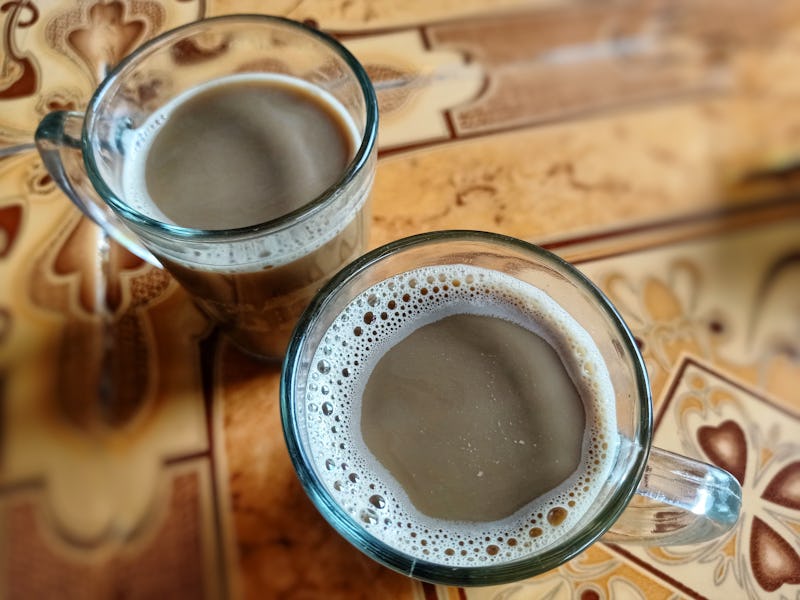Is decaf coffee caffeine-free? ‘Dr. Coffee’ shares the answer
Decaf and regular differ in other ways than caffeine levels.

Humans have a coffee obsession. Caffeine is the most widely consumed drug in the world, which largely comes from the hot bean juice that gives us our will to live. The drink has over 800 volatile organic compounds that concoct its signature bitter taste.
For those who get a little too jazzed from regular coffee, decaf offers a decent alternative. But how decaf is it really? Computational materials chemistry professor at the University of Oregon Christopher Hendon, a.k.a. Dr. Coffee, helps break down how true to its name decaf coffee is.
A cup of coffee contains about 95 milligrams of caffeine, compared to two milligrams in a cup of decaf.
Is there caffeine in decaf coffee?
Yes, but it’s negligible. Decaffeination removes at least 97 percent of the caffeine. Some companies claim to remove upwards of 99 percent, but Hendon’s skeptical. Perhaps that’s possible, but a coffee decaffeinated to that point might not taste good anymore. Caffeine, he says, is quite a bitter compound, so a good decaf coffee will actually taste different.
At the time, Hendon had a decaf coffee in his lab that was so mild he says it “tastes like a PB and J sandwich.”
A cup of coffee contains about 95 milligrams of caffeine, compared to two milligrams in a cup of decaf. The real test isn’t how little caffeine coffee contains, Hendon says, but when the caffeine stops supercharging the drinker.
“There’s going to be some point where you can think of it as microdosing,” Hendon tells Inverse. “You’re not going to respond to it — at least, not in some meaningful way.”
Is decaf healthier than regular?
Coffee has more to offer than just a jolt of energy to our nervous system. Antioxidants are a favorite compound in coffee, though “literally everything on earth contains antioxidants,” Hendon adds, which isn’t literally true, but it may mean that we give a little too much credit to naturally occurring antioxidants, which are in most fruits and vegetables.
Those who are sensitive to caffeine may still feel a rush from decaf, which may make it a better option. Those who are prone to anxiety but love their morning joe may opt for decaf. Research does show that decaf may pose some risks for those instructed to steer clear of caffeine.
For those who are coffee-curious but caffeine-wary, starting with decaf is an option. Since decaf and regular taste different because of caffeine’s absence, if one becomes accustomed to decaf they might be surprised at regular.
It is, in fact, possible to die of caffeine poisoning. The BBC reported in 2011 one man’s death from this cause after adding too much powder to a mixture. They reported the mix contained enough caffeine in 200 cups of coffee. However, that’s not reason enough to swear off caffeinated coffee. Hendon says that it takes 300 milligrams of caffeine — about half a liter of coffee — per kilogram of one’s bodyweight to poison themselves.
For those who are coffee-curious but caffeine-wary, starting with decaf is an option. Since decaf and regular taste different because of caffeine’s absence, if one becomes accustomed to decaf they might be surprised at regular.
How is decaf coffee made?
There are four primary methods for decaffeination:
- Swiss water process — Originating in Switzerland in the 1930s, this process entails soaking green, pre-roasted coffee beans in water and green coffee extract. Then, the solution filters through activated charcoal, which is full of chemical-trapping pockets that pull out caffeine. The mixture washes over the green beans again until nearly all the caffeine is gone.
- Supercritical CO2 process — Water-soaked green coffee beans sit in a stainless steel container as highly compressed carbon dioxide fills the container. At 73 to 300 atmospheres of pressure, CO2 acts like a liquid while maintaining its gaseous form. It lifts caffeine from the beans and floats out the vessel through an activated charcoal filter, trapping the drug.
- Direct solvent process — After soaking or steaming coffee beans, a solvent solution of methylene chloride or ethyl acetate removes soluble caffeine over the course of 10 hours.
- Indirect solvent process — The beans boil in water first, drawing out compounds that dissolve in water like caffeine. After removing the boiled beans from the liquid, methyl chloride is poured into the solution and evaporates the caffeine when heated. After the caffeine is fully dissolved, the beans go back into their boiling pot to reintegrate the flavor compounds that had been dissolved.
Really, decaf coffee is a beverage in its own right. Perhaps it can be thought of as a mellow cousin of coffee than its more lethargic counterpart. With its own manufacturing process, it has separate qualities worth appreciating. And while it’s not literally caffeine-free, it probably won’t get your heart racing at 8 a.m.